
Jackson station is a historic Amtrak station in Jackson, Michigan, United States. It is served by three daily Wolverine trains between Chicago and Pontiac and a single daily Amtrak Thruway bus between Toledo, Detroit, Jackson, and East Lansing. The station was added to the National Register of Historic Places in 2002.

Ambler's Texaco Gas Station, also known as Becker's Marathon Gas Station, is a historic filling station located at the intersection of Old U.S. Route 66 and Illinois Route 17 in the village of Dwight, Illinois, United States. The station has been identified as the longest operating gas station along Route 66; it dispensed fuel for 66 continuous years until 1999. The station is a good example of a domestic style gas station and derives its most common names from ownership stints by two different men. North of the station is an extant outbuilding that once operated as a commercial icehouse. Ambler's was the subject of major restoration work from 2005–2007, and reopened as a Route 66 visitor's center in May 2007. It was added to the U.S. National Register of Historic Places in 2001.
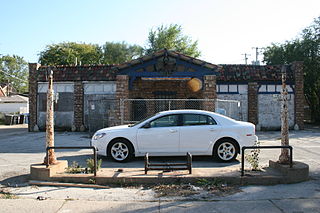
The Four Nineteen Building is a historic gas station building located at 419 E. 83rd St. in the Chatham community area of Chicago, Illinois. The station was built in 1928 by William D. Meyering and David L. Sutton, two local real estate businessmen. The station is an example of the Domestic style of gas station architecture, in which stations were designed to resemble small houses. A wooden canopy supported by brick piers covers the building's front entrance and two garage bays extend from either side, making the station part of a subtype of the Domestic style appropriately named "House with Canopy and Bays". The station's walls are built with clinker bricks laid in a skintled pattern, a combination of two Chicago construction innovations. Clinker bricks were heated at higher temperatures than standard bricks, making them swollen, dense, and differently colored; the bricks were generally discarded until the 1920s, when Chicago architects began to build with them. The skintled pattern of brickwork consisted of rough and irregular bricklaying in which bricks stuck out of and into the wall at different angles. The building's parapet roof is tiled with multicolored Mission style clay tiles, which were thought to pair well with skintled walls by architects of the era. Gas stations constructed from the 1930s onward generally had more functional designs, and as of 1999, the Four Nineteen Building was one of only sixteen Domestic-style gas stations remaining in Chicago and one of three with both a canopy and bays.

The Rison Cities Service Station is a historic automobile service station at Main and Magnolia Streets in Rison, Arkansas. It is a distinctive modest brick English Revival structure built in 1938. It has a cross-gable roof, in which there is a small oculus in each of the gables. The front facade has large plate glass windows flanking a central doorway. It was built and operated by the Arkansas Fuel and Oil Company, which operated it from 1938 to 1969 as a Cities Service station. Since then it has been seen various commercial uses.
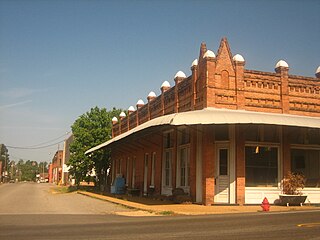
The King–Whatley Building is a historic commercial building at the northwest corner of Maple and 2nd Streets in Lewisville, Arkansas. The single story brick building was built c. 1902 for the First National Bank of Lewisville, and later house legal offices and title companies that played an important role in the area's land development in the early decades of the 20th century. The building has a distinctive curved canopy, and a parapet rising above the flat roof which is studded with brick piers topped by rounded concrete caps.
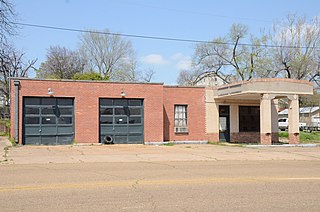
The Wallace Adams Service Station is a historic automotive service facility at 523 East 3rd Street in Texarkana, Arkansas. It is a single-story brick building with flat roof, with a covered service bay projecting from the front, supported by brick columns. It was built c. 1929, and is the only surviving service station of its period in the city. Wallace Adams, the proprietor, lived in a house that stood next door.

The Gulf Oil Company Service Station is a former automotive service station at Main and South Third Streets in Paragould, Arkansas. Built in 1926, it is a single-story brick building, with a canopied area similar to a porte-cochere supported by brick columns. The building has stylistic elements giving it a vague Mediterranean appearance, including an entablature with egg-and-dart molding beneath a metal cornice and parapet. It is divided functionally into four rooms: an office, two restrooms, and a tool storage area. The building was used as a service station until 1969.
The Rector Waterworks Building is a historic civic building at 703 South Main Street in Rector, Arkansas. It is a single-story brick building, with a false gabled front masking a flat roof. The front facade is three bays wide, with the outer bays filled with pairs of round-arch windows. The center bay has a slightly recessed double-door entry, with a sheltering gable-roofed portico which is supported by brick piers. The bays are separated by brick pilasters. The building was erected c. 1928 as part of the city's first water supply system. For a period of about 15 years the building also served as the local jail.
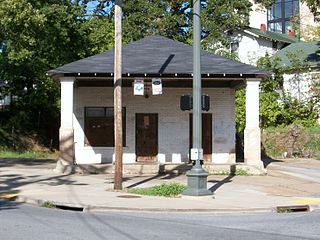
The Magnolia Company Filling Station is a historic automotive service station building at 492 West Lafayette Street in Fayetteville, Arkansas. It is a small single-story white hip-roofed brick building, with a portico, supported by brick piers, extending over the area where the fuel pumps were originally located. The building has a center entrance, with a single sash window to the left, and a large window to the right. Built in 1925, it is one of the region's oldest surviving gas stations, and, according to its National Register nomination in 1978 was the only one then known to have been built by the Magnolia Company and to still be surviving.

The Newport station, also known as Missouri-Pacific Depot-Newport, is a historic railroad station at Walnut and Front Streets in Newport, Arkansas. It is a long rectangular single-story brick and stucco topped by a hip roof, whose wide eaves are supported by large Italianate knee brackets. Its roof, originally slate, is now shingled, detracting from its original Mediterranean styling. A telegrapher's bay extends above the roof line on the track side of the building. The building was built in 1904 by the Missouri-Pacific Railroad to handle passenger and freight traffic.
The Ferguson Gas Station is a historic automotive service station at Center Street and United States Route 65 in Marshall, Arkansas. It is a small single-story structure, with sandstone walls and brick quoining at the corners and openings. It has a steeply pitched gable roof, with a slightly projecting cross gable above the entrance. The station was built about 1927 by Zeb Ferguson, in a style first popularized by the Pure Oil Company.
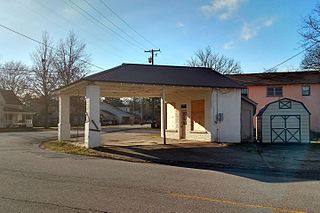
The Mount Ida Cities Service Filling Station is a historic automotive service station at 204 Whittington Street in Mount Ida, Arkansas. It is a small five-sided frame structure, finished in brick covered with stucco, with a hip roof that extends to form a canopy over the service area, with supporting brick piers at the far corners. Its front has fixed four-pane windows flanking a center entrance. Built in 1925 by Cities Service, it was used as a gas station until 1966, and has since housed a variety of small businesses. Its role as a gas station was briefly resurrected in the film White River Kid, which was shot here in 1998.

The Langdon Filling Station is a historic automotive service station at 311 Park Avenue in Hot Springs, Arkansas. It is a single-story masonry building, constructed out of concrete blocks and finished with brick veneer, and houses three service bays and a small office and storage area. The building has a steeply-pitched roof with rectangular vents in the English (Tudor) Revival style. Built about 1938, it was used as a service station into the 1990s.
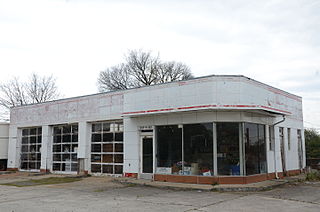
The Esso Standard Oil Service Station is a former automobile service station at 1600 West 3rd Street in Little Rock, Arkansas. It is a single story rectangular building, built out of concrete blocks and finished with a baked enamel on steel exterior. It has three service bays on the left side, with original overhead glass-paned doors, and an office and sales space on the right side. The right side has a short canopy protruding from it, also built of concrete with a baked enamel finish. Built in 1957, it is a rare mid-century service station in the city.

The Rock Island-Argenta Depot is a historic former railroad station at 4th, Beech, and Hazel Streets in North Little Rock, Arkansas. It is a single-story brick structure with a roughly cruciform plan. It has a gabled red tile roof with parapeted gable ends, in the Mediterranean style common to railroad stations of the Rock Island Railroad. The building houses two waiting rooms, with the telegrapher's bay projecting on the former track side, and a baggage room projecting on the street side. Built in 1913, it is a well-preserved example of a Rock Island station, and a reminder of the importance of the railroad to the city's growth.
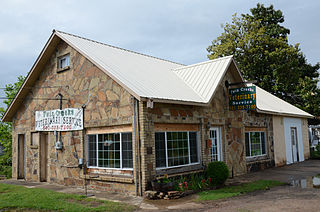
The Lee Service Station is a historic commercial building at 28 South Broadway in Damascus, Arkansas. It is a single-story frame structure with a cross-gable roof configuration, its exterior finished in stone veneer with brick trim. It has a single former garage bay on the right side, the bay opening now enclosed with a pedestrian door at its center. To its left is an office space, with a center entrance flanked by a large multi-pane windows. Door and window openings are trimmed in brick laid in a three-in, three-out pattern, and the stone veneer is in a herringbone pattern. These design elements are all signatures of the builder, Silas Owens, Sr., the master mason who finished the exterior about 1940. The building served as an automobile filling and service station through the 1950s, and has since seen a variety of other commercial uses.

The former Morrilton station is located on Railroad Avenue, between Division and Moose Streets, in downtown Morrilton, Arkansas. It is a single-story brick building, with a tile roof and Mediterranean styling typical of the stations of the Missouri Pacific Railroad. The broadly overhanging roof is supported by large brackets, with a telegrapher's bay projecting on the track side. Built about 1907, it is an important reminder of the railroad's importance in the city's history. It now houses a local history museum.
The Ellis Building is a historic commercial building at 208 North Block Avenue in Fayetteville, Arkansas. It is a single-story brick building, with a hip roof that has a rounded top section. The roof's shape is obscured from the front by a low stepped parapet. The front facade has a former garage bay opening to the left, and a pair of plate glass display windows flanking a pedestrian entrance to the right. The building was under construction about 1923, and is one of the oldest surviving automotive service buildings in northwestern Arkansas. It has housed a variety of commercial businesses since ending automotive use about 1955.
The Gulf Oil Company Filling Station is a historic automotive service station building at 131 Main Street in Stamps, Arkansas. It is a single-story brick building, with a portico, supported by brick piers, extending over the area where the fuel pumps were originally located. The portico extends from the portion of the building housing what originally served as the station office, with two automotive service bays to its right. The station was built about 1930, to a corporate design introduced by Gulf Oil in the 1910s, and is painted in that company's colors: white, blue, and orange.
The Magnolia Petroleum Company Filling Station is a historic automotive service station building at Larch and 1st Streets in Kingsland, Arkansas. It is a small single-story masonry building, built of red and buff brick and covered by a gabled roof. The front facade has a door on the left side and a plate glass window on the right. A concrete pad in front of the building originally supported the fuel pumps. The building was built about 1930, and is a good example of an early filling station with Tudor and Craftsman features, built to a Magnolia Company design which was used for at least one other filling station, in North Little Rock.

















